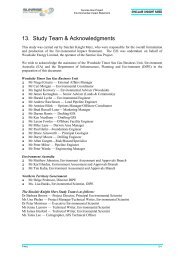Appendix D Terrestrial and Aquatic Biodiversity - Environment ...
Appendix D Terrestrial and Aquatic Biodiversity - Environment ...
Appendix D Terrestrial and Aquatic Biodiversity - Environment ...
Create successful ePaper yourself
Turn your PDF publications into a flip-book with our unique Google optimized e-Paper software.
4.3.2 Vegetation Condition<br />
The fire regime suggested from NAFI together with evidence inclusive of vegetation types such as a very<br />
thick st<strong>and</strong> of Eucalyptus tetradonta, extensive areas lancewood, patches of Callitris intratropica in good<br />
condition together with the average scorch height in most other vegetation types suggests that the general<br />
area does not exhibit significant disturbance from fire. However, there are some localised areas which<br />
suggest these areas may be burnt frequently or suffer from fire damage due to their drier nature such as the<br />
southern low hills. Extensive areas were burnt in 2011 (but early season burns). Overall, possibly the<br />
remote location (which reduces the probability of human induced fire) together with the extensive inundated<br />
areas <strong>and</strong> the rocky ridges may offer some protection from frequent broadscale fire.<br />
No weeds were identified within the survey area, <strong>and</strong> there was low impact from stray livestock <strong>and</strong> feral pigs<br />
at the site.<br />
4.3.3 Notable Flora Records<br />
No threatened flora species were recorded during the surveys, however there are several species that are<br />
notable records for the region (i.e. range extensions or species listed as either Near Threatened or Data<br />
Deficient under the TPWC Act).<br />
Psydrax paludosa<br />
Psydrax paludosa (Data Deficient) is a large shrub to small tree 3 – 4m high, with small greyish leaves.<br />
When young, the leaves of the tree are smaller <strong>and</strong> the growth structure reminiscent of Terminalia species –<br />
see Figure 15.<br />
This species occurs in Qld (24 records in the QLD Herbarium) <strong>and</strong> the NT (three records including<br />
specimens collected February 2012 on lease area). The majority of records are on the Cape York<br />
Peninsula. In the NT, the few herbarium records are sourced from two general localities: from tributaries of<br />
the Towns river <strong>and</strong> near Bing Bong where it is associated with shallow swamps or minor drainage lines with<br />
Melaleuca viridiflora <strong>and</strong> Asteromyrtus symphyocarpa. In the lease area the species was recorded from a<br />
total of 4 sites which closely match the habitat previously described for this species.<br />
Psydrax paludosa occurs predominantly on Vegetation type 17 Melaleuca viridiflora +/- Asteromyrtus<br />
symphyocarpa, Psydrax paludosa Low Open Woodl<strong>and</strong>, where it is one of the dominant species.<br />
In the NT this species is classified as data deficient meaning that appropriate data on abundance <strong>and</strong>/or<br />
distribution are lacking in order to define whether the species is threatened or otherwise. However unlike<br />
some other cryptic species, which can easily be overlooked, this large woody species is unlikely to have<br />
been overlooked in areas that have been surveyed.<br />
Likely effect of mining disturbance on species<br />
Most of the potential distribution of this species is close to the proposed areas of direct disturbance with the<br />
pit area bisecting vegetation type 17. Potential impacts include direct disturbance to wetl<strong>and</strong>s due to the pit<br />
<strong>and</strong> re-alignment of waterways. Sedimentation downstream of the pits is also a risk for a proportion of the<br />
population. Being a perennial species that is long lived, there would be some resilience to changes in<br />
hydrology <strong>and</strong> sedimentation but in the longer term these factors may reduce recruitment of new plants.<br />
Upstream of the pit changes in surface hydrology could result in changes to the inundation regime. The<br />
maintenance of the ‘gaps’ between the low ranges would be important as they would limit or hold back water<br />
flows which would result in flooding upstream of the gaps. Widening <strong>and</strong> deepening of these gaps may<br />
contribute to a large change in flooding regimes.<br />
Client: Western Desert Resources Ltd Page 58 of 150<br />
Doc No. DW120004-C0302-EIA-R-0036<br />
Doc Title: <strong>Appendix</strong> D – <strong>Terrestrial</strong> <strong>Biodiversity</strong> Technical Report



